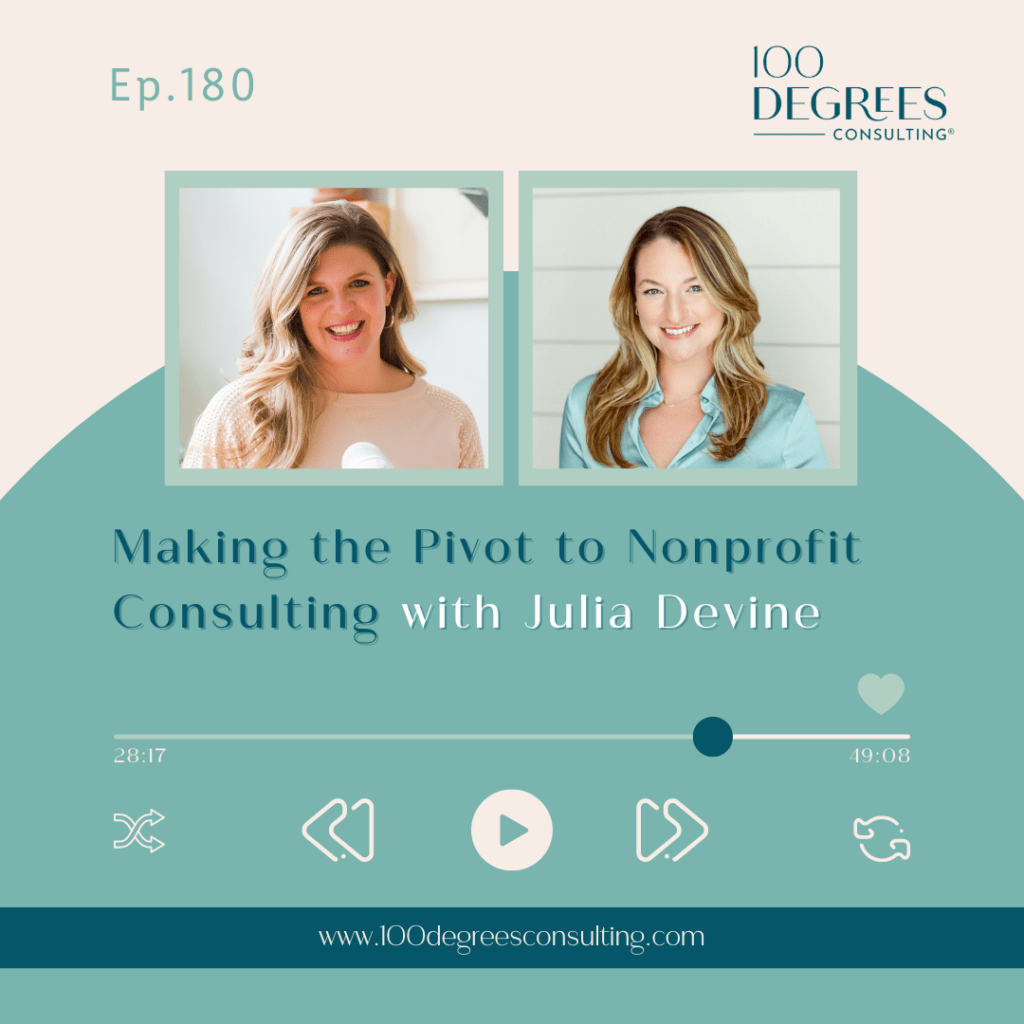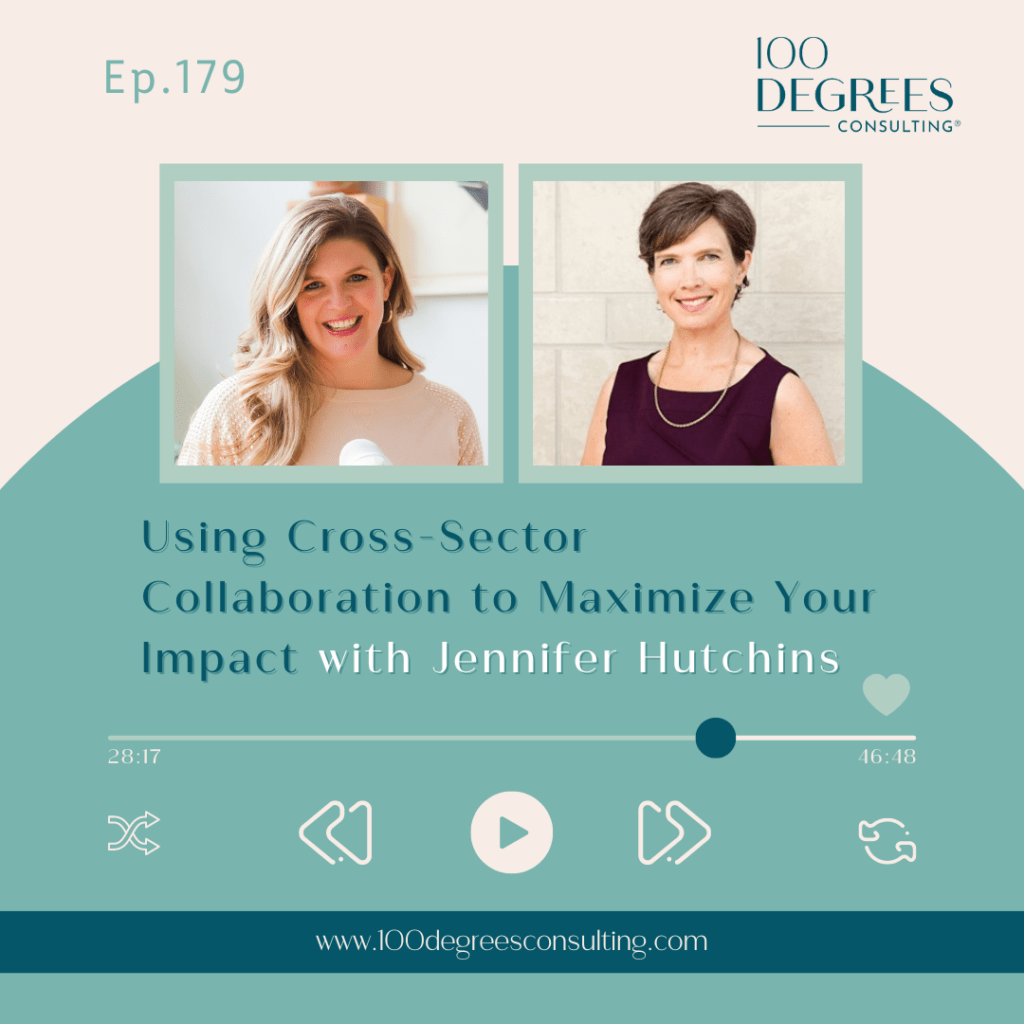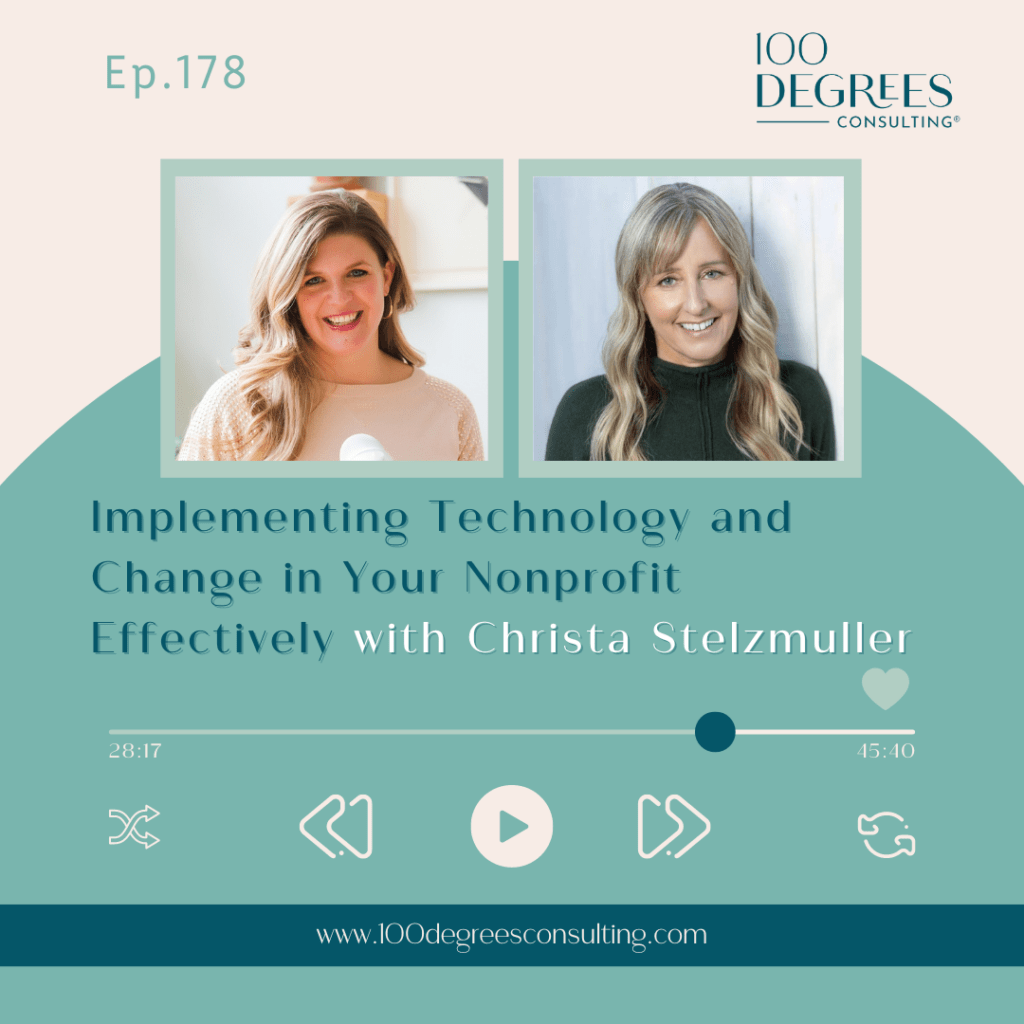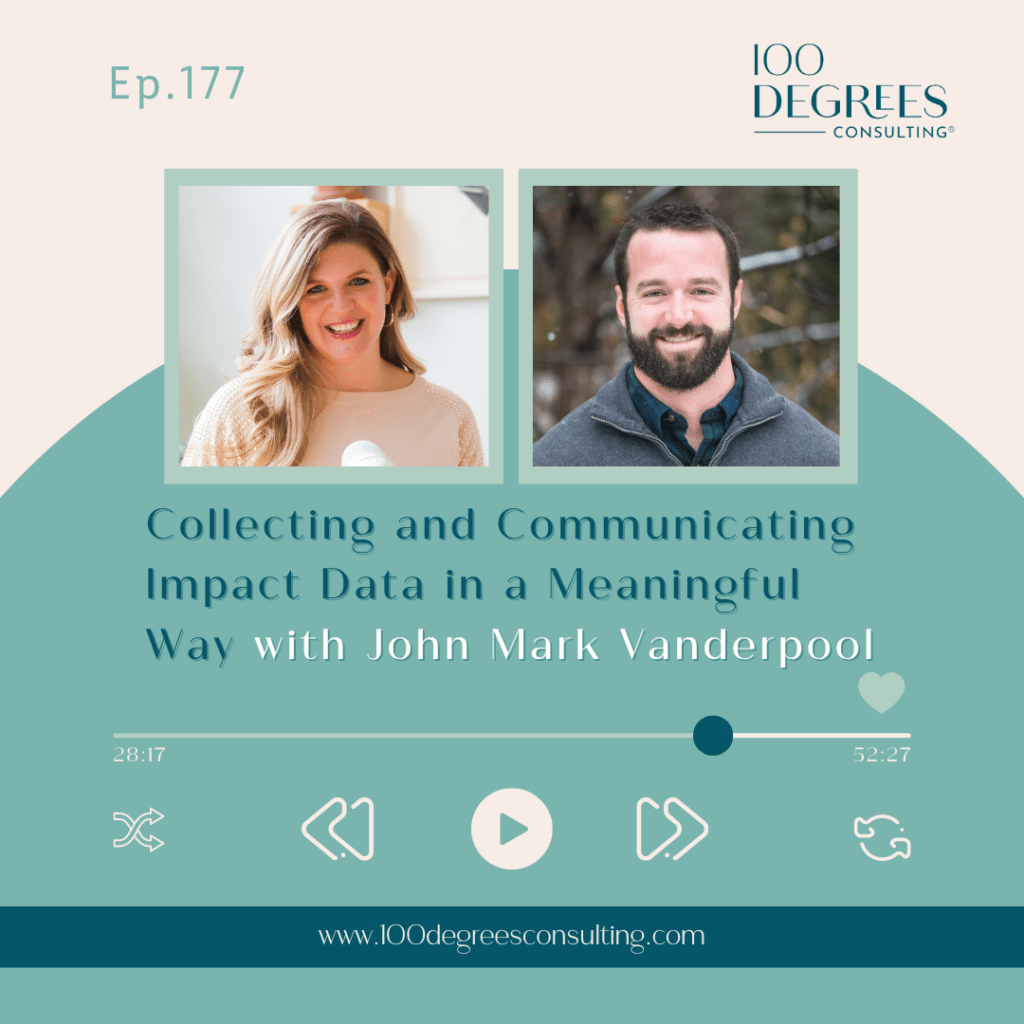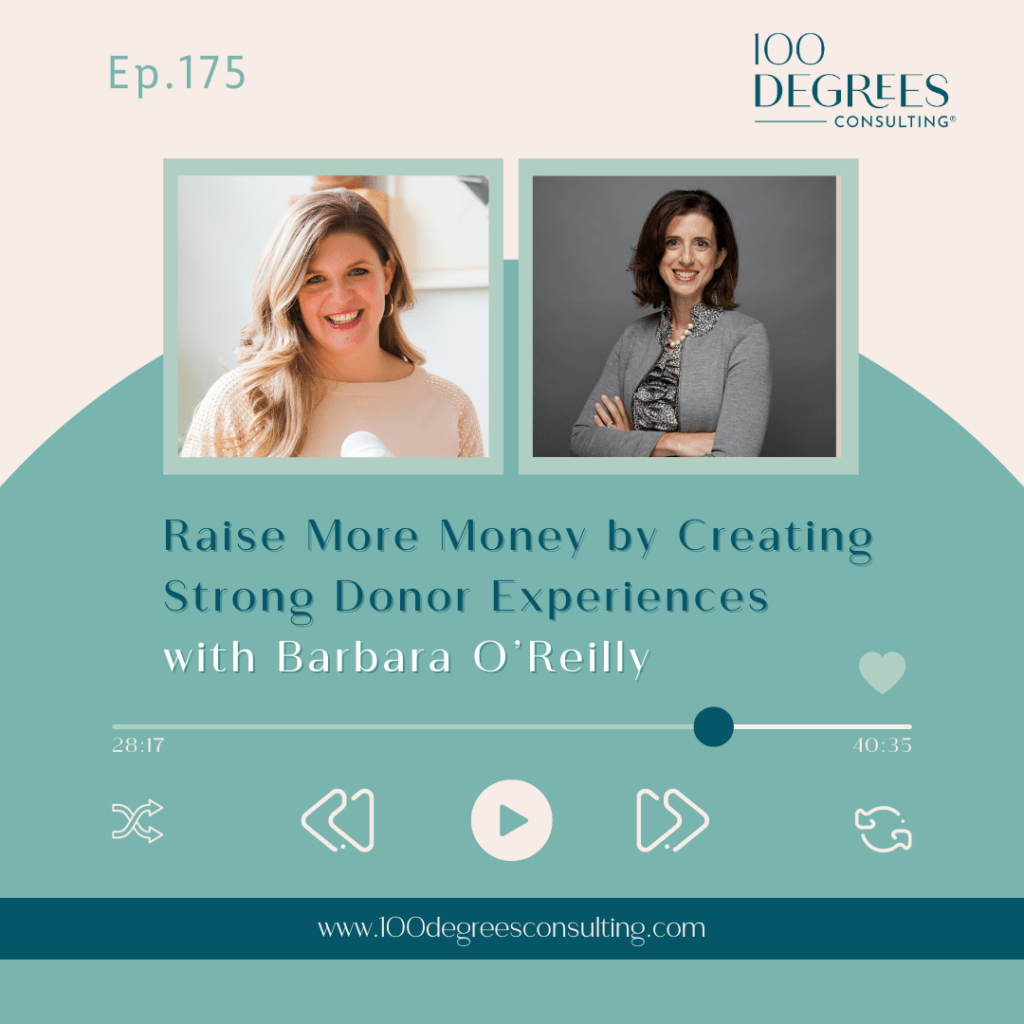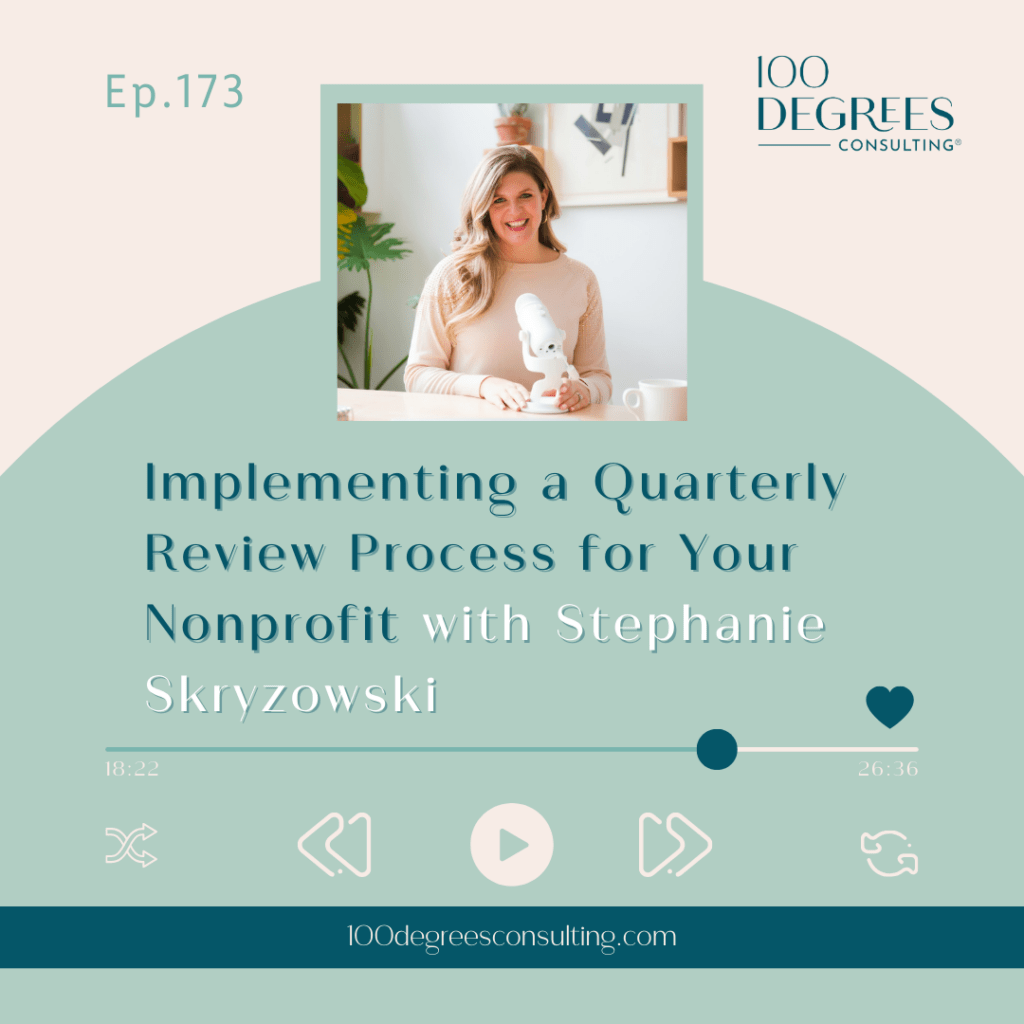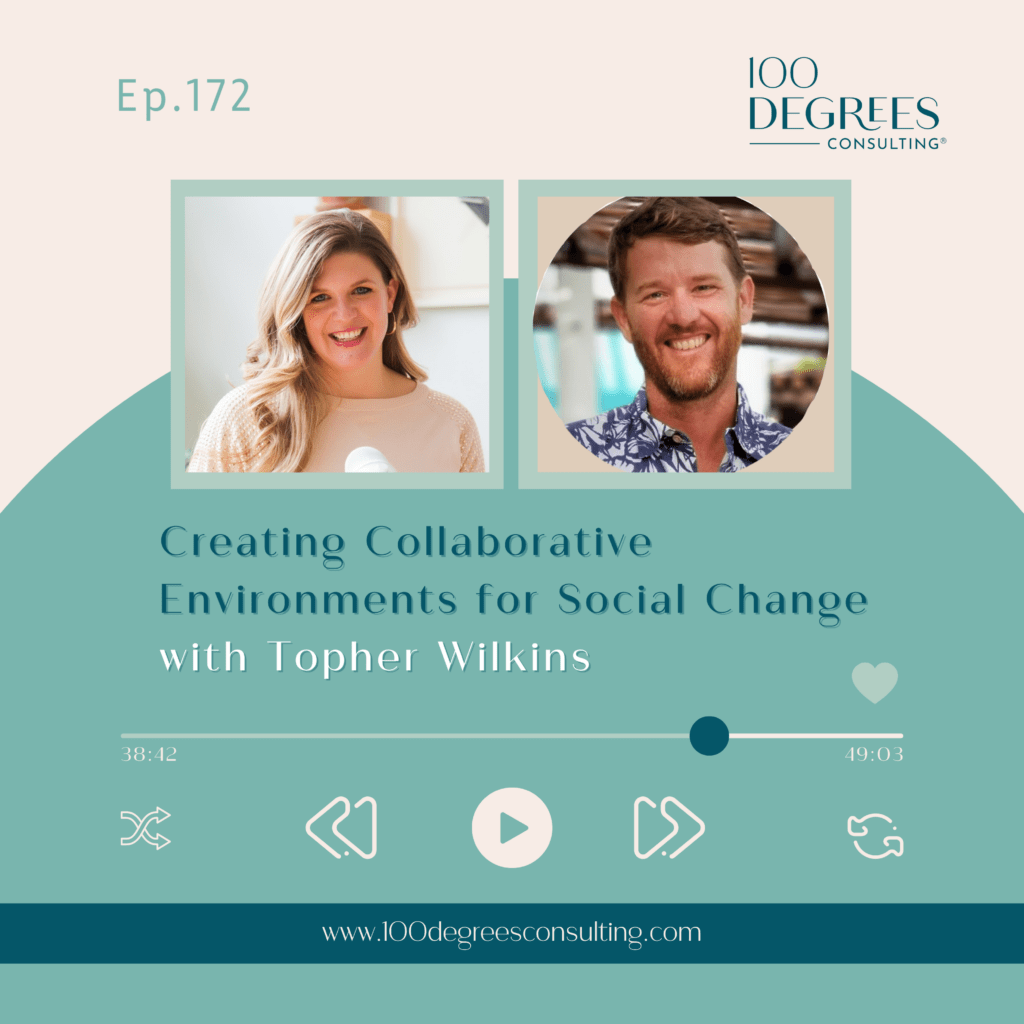Transcript Episode 181 – The Power of a Strong Parental Leave Policy with Lacey Kempinksi on The Prosperous Nonprofit
TPN _181 – Lacey Kempinski_24Y08M15D_mixdown
[00:00:00] Stephanie Skryzowski: Welcome to the prosperous nonprofit, the podcast for leaders who are building financially sustainable and impactful nonprofits and changing the world. I’m Stephanie Skrzewski, a chief financial officer and founder and CEO of 100 degrees consulting. My personal mission is to empower leaders to better understand their numbers, to grow their impact and their income.On this show, we talk to people who are leading the nonprofit sector in new. Innovative, disruptive, and entrepreneurial ways, creating organizations that fuel their lives, their hearts, and their communities. Let’s dive in.
Hello, welcome back to the prosperous nonprofit. Today, I have a really good episode for you because this one is unlike any other one that we’ve done before, right? We talk a lot about fundraising. We talk a lot about finance, but [00:01:00] here’s something that we don’t talk about. Parental leave coverage. Okay, so today I’m talking to Lacey Kempinski from Balanced Good and we are talking today all about parental leave coverage and that’s what her company does.
So let me tell you about Lacey and then I will tell you about our conversation and then we’ll go talk to her. So Lacey Kempinski is an in house fundraiser turned mom, turned consultant. After more than a decade of in house fundraising, motherhood changed the trajectory of her career. In 2018, when she was due back to work after her second parental leave, Lacey took a leap and founded Balanced Good.
She is on a mission to better support parents and organizations in the nonprofit sector. Balanced Good provides parental leave coverage from day to day hands on work to big picture transition planning. Balanced Good believes that a supported transition to parenthood will benefit both our sector and the parents working in it.
Laci has a bold vision that all parental leaves are viewed as a celebrated life milestone and [00:02:00] not a feared employment gap. She’s a graduate from McMaster University and Georgian College’s Fundraising and Resource Development program. She loves continuing to immerse herself in all things fundraising.
Also balancing that with Lego building, endless folding of laundry and a love for hiking, canoeing, and all things outdoors. So listen, yes, that is what she does. Balance good. Her company provides parental leave coverage for nonprofit leaders. So whether that’s fundraisers or marketing communications people or senior leadership, like executive directors, her company will put.
An experienced, highly qualified person in that seat while that person is on their parental leave. And now listen, she works in Canada and so Canadians have 12 to 18 months of parental leave, which is much more than we have in the US, but she does work with American organizations as well and does help provide coverage even for our short.
Three months maternity leaves. So this is an awesome episode. I think, you know, we’d love to [00:03:00] talk about how organizations, how people are operating in new entrepreneurial disruptive ways like this is new. I love this idea. And, and Lacey shares some of the major, major benefits of providing coverage for Parental leave rather than just throwing all of that person’s responsibilities onto other people on the team.
Right? So she’s going to share all the benefits with us. Such a good episode. And without further ado, let’s go talk to Lacey.
Hey everybody. Welcome back to the prosperous nonprofit. I’m really excited for the conversation that Lacey Kempinski and I from Balance Good are about to have. Lacey, welcome to the show. Hi
[00:03:45] Lacey Kempinski: Stephanie, thanks so much for uh, inviting me. I’m so thrilled to be talking to you and diving into some topics about parenting. [00:03:54] Stephanie Skryzowski: Yes, uh, parenting. I love it. This is going to be such a good conversation because the [00:04:00] work that you do at Balance Good is unlike anything I’ve Really, I don’t know anybody else that does the work that you do. So why don’t you first tell us about what you do at Balance Good, and then I’m going to ask you to kind of go back in time and kind of take us along the journey that led you to doing what you’re doing now. [00:04:16] Lacey Kempinski: Wonderful. Thanks. Yeah. So as you kind of hinted at, I don’t think there are any other organizations doing the work that we’re doing at Balance Good. And so what we do at Balance Good is we’re supporting Um, nonprofits through the parental leave journey. We know our sector is made up of predominantly women.That’s not always the case and there’s lots of men and gender expansive people in our sector. But you know, about 77 percent of our sector is women, which means there’s also a lot of parental leaves and parental leave gaps. So what we do at Balance Good is we come in and we actually fill those gaps, so we cover the roles so that when women and parents return to work, their role has been thoughtfully covered, the work has been [00:05:00] done, team members aren’t feeling the Frustrated because they had the burden of doing all of the extra work, um, and leaders can relax knowing that work continues when somebody is, is off on leave.
I will be open and honest that I am from Canada. And so my perspective of parental leave is a little bit different than a lot of my American friends in Canada. We have 12 to 18 months of paid parental leave, and we’re so lucky and fortunate for that. But that Creates huge gaps in the marketplace for work, but I’m seeing more and more now organizations in the U.
S. Are investing in our services as well, because sometimes the shorter leaves actually need more support because that woman or parent is coming back to the sector at quite a vulnerable stage and quite fresh in their parenting journey, and that extra help is really needed. So that I guess in a nutshell is balanced good, and I’m sure we can dive into it a little bit more.
[00:05:55] Stephanie Skryzowski: Yes. And so what types of roles do you cover? Are [00:06:00] you like, is it just fundraising? Is it just executive leadership? What types of roles do you help cover? [00:06:05] Lacey Kempinski: Great question. So it first started out just as fundraising, cause that was my experience. Experience and my expertise in the field. Um, but as we’ve grown, so have our offerings, and I’m so thrilled to share that not only can we cover fundraising roles, marketing and communication roles, leadership roles, executive leadership roles, we are also building so we can support program-based roles as well.So program development, program direction, um, all of that really recognizing that the, the whole sector needs this service, not just fundraising professionals.
[00:06:37] Stephanie Skryzowski: Yes. Oh my gosh, that’s amazing. How did you get here? Like, how, where, where did this idea come from? You mentioned your experience was in fundraising, but like, what did the journey look like to get you here? [00:06:48] Lacey Kempinski: Yeah. I mean, I think like every entrepreneur, there’s this piece of this personal piece for me in this journey. Um, so [00:07:00] it was about six years ago that I, I launched Balance Good. But even before that, I didn’t realize that I was launching this. This vision, um, for the future, my journey to become a mom and a parent started with fertility challenges that I hid from my employer.Like so many other women, you’re trying to navigate these secret doctor’s appointments and balancing all of that. And then when I became, it’s hard, it’s really hard. Um, and then when I became a mom, Like so many other women and parents, I struggled with postpartum depression and anxiety. So there was a lot of emotional roller coaster in my journey with motherhood.
One thing that was really important to me in all of this was the passion that I had for my career. But unfortunately, I couldn’t find how to balance that passion. With also being the mom that I wanted to be, especially after the journey I had been through. So I decided not to go back to my traditional shop, which was like a major gift shop.
And [00:08:00] I decided to start my own work, knowing that maybe if I could help some other women in leadership roles, take some work off their plate, they could spend more time with their family, have more autonomy. I could have more autonomy. That would be great. And then one year later, we realized we were onto something with supporting directly parental leave.
So we really niched down and focused and really focused on covering parental leaves and supporting working parents in the sector. And really, I haven’t looked back since I have had another kid since, but I haven’t looked back since on, on my journey and how we’re building the business.
[00:08:33] Stephanie Skryzowski: Yeah, that is incredible.And what do organizations normally do for covering parental leave? Um, like you mentioned, you’re in Canada, so 12 to 18 months, whereas in the U. S. we’re like maybe three months. Um, maybe more than that if your employer happens to be particularly generous or you’re taking unpaid leave. But what do organizations do if they’re not working with you?
Like what do normal organizations do [00:09:00] for somebody’s parental leave?
[00:09:01] Lacey Kempinski: Yeah. So it really is like a mixed approach. So some organizations, they definitely go out to the traditional hiring market and they, you know, post the job and they fill the role or try to fill the role for 12 to 18 months. Some challenges with that, especially for leadership or even mid level roles is that they can’t find the qualified candidates who would be willing to leave a job for a temporary job.So then they’re either taking a more junior person to filling this role, um, or they’re not able to find the candidate. And then the other alternative that we see a lot is that they work share. So they look at the team and they split the work amongst the team, but really that just leads to more burnout, more turnover.
And that like, it’s just repeating this culture of martyrdom that we love to have in our sector of like, our plates are already full, but we’ll take on more because it’s for the cause. And that’s really not good. And there’s, there’s costs. Long term organizational cost to that. Um, and then I think and [00:10:00] you, Stephanie, can probably speak to this more.
But in the States, really, what we see is that This workload is being dumped on somebody else or, you know, oftentimes I’ve seen it’s just ignored. It’s just like, okay, well, we just won’t do that work for three months. And then you have a new parent coming back who’s probably still nursing for sure is still physically recovering, emotionally recovering, mentally recovering, and they come back and they have three months of work to catch up on.
Plus moving forward, like that feels impossible.
[00:10:30] Stephanie Skryzowski: Absolutely. Yeah, I, I don’t, I can’t speak from experience because I had my first daughter, um, when I, I had both my kids when I owned my business. So I did not have a like, maternity leave from an organization, from a company and, you know, experience that coming back.But I can imagine you’re totally right. And I’ve seen this, you know, in our own company, we’ve had a couple people go on maternity leave. And again, it’s a three months paid and we’ve done kind of similar to what you said. Like, okay, [00:11:00] some stuff is going to be put on hold. Um, we’re going to cover some things, make sure their email inbox doesn’t get, you know, overwhelmed.
We’re going to keep that cleaned up for them. We’re going to cover work here, there, and it’s just this sort of piecemeal approach that means that you’re right. I remember when one person came back from maternity leave, we had this like running list. That we were like, okay, when she’s back, we’re going to tackle X, Y, and Z because we haven’t really been able to do that while she’s gone.
And yeah, I, I mean, we were very mindful about like, not day one, here’s the whole, all, everything you need to do, but, but that just meant that there was a bit of a pause for our company. Like we couldn’t move. Company initiatives forward because we didn’t have this person. So anyway, yeah, it’s that’s really challenging.
And so I love this gap that you feel. So what does the process look like? Tell me what the process looks like. How do potential clients come to you and how do these people that are going to sit in the roles, like how do they come to you? How does that all work?
[00:11:59] Lacey Kempinski: [00:12:00] Yeah, so we have an internal team of fundraising experts and nonprofit experts in a varying scale, and we’re a team that’s growing quickly because the demand is growing, which is super exciting.And I know that this is something, Stephanie, you can probably relate to as well. So we have All of this in house skill and so when people come to us for parental leave fills often it right now it really is through word of mouth we are building brand awareness and stuff but they come to us we talk about the role we talk about the deliverables in the role what are the expectations what are the key projects and deadlines that need to happen and we build out a road map.
And then from there are, we always try to recommend there’s some overlap so we can learn from the person going on leave. And then from there, we jump in, we integrate ourselves with the team. We go to team meetings. We really act as that person, but the benefit is you also have the expertise of the whole balance good team.
So sometimes, you know, if even if I’m, you know, when I was filling roles, I would say, go back to the team and go, I’m stuck on this. Can you help me? And so [00:13:00] the client has this like. This whole team of experts that are helping push the role forward. And then the key is when that person comes back, we’ve documented everything.
We put together, um, a couple of recommendations on how that role can be more working parent friendly. So that person can thrive in their role when they come back. And then we provide some overlap and transition because we know just jumping in is really hard to do. Um, and there’s going to be bumps along the road.
So if we can overlap. Then we reduce and smooth out those bumps for employers and the employee.
[00:13:33] Stephanie Skryzowski: Oh my gosh, that’s so good. I loved it. I love the like little value. I mean, it’s not little, but the value add of like, we’re going to put together some suggestions of how to make your job better for you now that you are a parent.Um, I think that is huge. And so of course, as a CFO, my mind is like, all right, what does this all cost? Because if you’re Paying the person who’s out on leave for 12 to 18 months, or does that like go through the [00:14:00] government somehow?
[00:14:00] Lacey Kempinski: Yeah, so it is tricky. So in Canada, we, we get paid 55 percent of our salary for the 12 month leave.It’s prorated for the 18 month leave. And then some employers Um, provide top up on salary, but it’s only like 35 percent of employers in Canada have like a formal top up policy in the nonprofit sector. So it’s not, you know, the bulk. Um, so in most cases, organizations have this salary already in their budget, right?
[00:14:28] Stephanie Skryzowski: Okay. Yeah. [00:14:29] Lacey Kempinski: So they’re able to typically our services. Come out in and around that salary mark because it’s based on the deliverables on the seniority of the job. So if you, you can assume if your salary is fair market, fair value salary, it’s likely going to be around where we come in at for the role. It just depends on seniority.And like the role requirements, are you managing staff, et cetera, et cetera. Um, so in the States, and this is where, where we struggle, right? That that’s not the [00:15:00] case, right? The employer’s having to top this up. So we really have to create like, um, a value add discussion around what can we bring to the organization while this person’s on leave and what are the benefits of filling the leave or what are the costs of not filling the leave?
Yeah.
[00:15:20] Stephanie Skryzowski: Yeah, that’s what I was going to say. It’s like, I think a lot of times people think in a short sighted way that, okay, well, I don’t want to have to pay for two salaries for three to six months. So we’re just going to deal with it and put more work on other people. But I think what they don’t understand are the longer term ramifications of that, of continuing to just Pile work on your existing team.They’re going to burn out. Um, so it’s really interesting about the Canadian structure. It’s like the cost is not really even a factor. It’s like they have the money in their budget. So why wouldn’t we fill [00:16:00] the role with somebody to help us out? So, okay. Any Canadian nonprofits that are listening, every single person or every single organization that has a friend to leave needs to go talk to Lacey.
Cause like, why not? Like, It’s why not, right? Like it’s 100%. Yeah. That’s like not even a question. I think, yeah. So let’s talk a little bit more to our us nonprofits, because I do think that organizations are like, well, three months salary. I can like save that. Yeah. And not have to pay like a second person.
Yeah, definitely. Um, I’m, I’m not going to go ahead and fill this role, but tell us what are the costs there if you don’t have maternity leave or parental coverage? Yeah, what are the costs instead?
[00:16:44] Lacey Kempinski: Yeah, and I think it’s really hard to give exact hard costs because it depends on the role and stuff like that, right?But when we’re talking about this, I think the first and foremost thing for me is the cost of undervaluing your current [00:17:00] employee by not supporting the work that they’re doing. And I think a lot of employers come at it from the kindest perspective, but what you don’t realize is when you’re not back filling their role, you’re undervaluing what they’re bringing to the organization while you’re there, basically saying, Hey, we can actually, we can just cover your role for three months.
You know that that doesn’t send a strong message to two people and not everybody looks at it that way. Right. Um, but when you do, you’re like, Oh, yeah, for sure. We should invest in this. Um, you’re also risking burning out your team members, right? When you’re adding more work to their plates. We know the nonprofit sector like they’re already.
Plates are full. We look at missed opportunities, right? So, I mean, this is easier to draw a connection when we’re thinking about fundraising roles, right? But like, what asks are, are not happening? What funds are not being raised? Which major gift donors aren’t being stewarded? And what are the costs of that?
But, you know, when I really circle back to it, I think it is about turnover because I [00:18:00] know for a lot of women and parents, they use those three months to job hunt. Right, because they say, Hey, my employer actually hasn’t looked at the value I’m bringing to the organization or they didn’t thoughtfully cover my leave.
I’m going to take this time to look for a new job. And now you have the cost of turnover, which can be anywhere from 30 to 55, 000 or more, depending on the role. Like I’ve seen some studies where it’s like it’s double that person’s salary. When you actually go to market to recruit, to train, um, to interview and all of that time put into it.
Um, so when you think that way, you’re like, Oh, Well, three months salary really isn’t that bad then.
[00:18:38] Stephanie Skryzowski: Yeah. Yeah. That’s a really good point. And to your point about people using time on their parental leave to look for new jobs, I think that’s a really good point. If they’re like, yeah, there’s absolutely no way that I’m going to be able to come back, that I can do this job with a baby at home.Cause it’s just not set up that way. I think that goes back to your point of. [00:19:00] The way that you help your, your clients help them create a better, you know, shape the role for a working parent, um, to work better. And I think, yeah, that is a huge risk. That’s so interesting. So how do organizations like budget for this?
Right. Obviously we cannot go and ask our team, do you plan on getting pregnant this year? Um, so you can’t do that. So how does an organization plan on this?
[00:19:26] Lacey Kempinski: I mean, I think there’s there’s partially this fact of, like, looking at the reality of the job market and the landscape. Um, we have a large portion of our sector that are women.Um, so, you know, you can take that for what it is and say this is something that we should have budgeted for, you know, reasonably annually, depending on the size of your team, right? It’s hard because if you look at, say, um, post secondary education, Institutions versus like a small shop with one person. The needs are very different, right?
But I think setting aside [00:20:00] those funds, I think there are also and I have like, I’m just tossing this out here now, but there’s this place where this could also be something that’s really Interesting to your donors, right? Um, when you’re talking about here’s a way to invest in our team and investing in women and women and equity in the space of non profits, right?
So, you know, we’re looking at unique ways to cover parental leaves. Is this something you would be interested in covering, right? So we can keep moving our mission forward while our team is It’s also building their family, right? So it’s, it’s an interesting thing. I’ve had a few people bring that up to me and I’m like, yeah, there, there could be something there.
Um, but I think it’s really about having the foresight to put that money away in reserves and know that you might.
[00:20:51] Stephanie Skryzowski: Yeah, that’s so smart. That is so smart. Building that into your financial plan and then just, and knowing that you have that money in reserves. to pull [00:21:00] from when it’s time.Are you tired of navigating the labyrinth of software options? Wondering what works best together and how to afford it all? It is a dizzying task from choosing the right accounting software to ensuring seamless integration between all the systems, feeling lost in the jargon. Fear not introducing the best tools for an efficient and prosperous nonprofit.
This free resource is a curated collection of top notch software solutions personally endorsed by our team at 100 degrees consulting. Visit 100degreesconsulting. com slash tools to access our handpicked list designed to streamline your operations and boost your nonprofit success without Adding a ton of extra cost or extra team.
Don’t miss out. Head to 100degreesconsulting. com slash tools now to download the best tools for an efficient and prosperous nonprofit. [00:22:00] Let’s elevate your nonprofit to new heights.
I think for a 12 to 18 month parental leave, 100%, it’s so worth having somebody sitting in that role. Cause like you can’t have fundraising stop for a year and a half or slow down. I mean that could be like really, really detrimental, tragic to an organization, but three months, how does a parental leave person that’s filling in, how do they get up to speed and like actually get work done in only three months?
I feel like that’s, you know, sometimes it takes. that long just to onboard somebody. So how, yeah, how do you make a meaningful impact in that amount of time? We like to say
[00:22:42] Lacey Kempinski: that we’re really, really good at just diving into things. We’ve, as we’ve done this, we’ve really realized, okay, this is the information I need.This is the information I actually don’t need and filtering it out. Um, we remove ourselves from meetings that aren’t What we deem, you know, [00:23:00] required, um, because we’re focused specifically on the deliverables of that role. Right. So we’re not looking at like, okay, we need to build long term culture in this organization.
We need to build long term relationships. No, we need to move the things forward and make sure the team that we’re directing has what they need to keep moving things forward too. So we’re pretty targeted in what information we take in and how we move things forward. I think that’s the key there.
[00:23:28] Stephanie Skryzowski: Yeah.Yeah. That’s great. I feel like that’s a lesson for all of us. Let’s not go to meetings. We don’t need to
[00:23:34] Lacey Kempinski: go to. Honestly, honestly. And oftentimes, like a lot of our recommendations come from things like that. Like we noticed that you spent X number of hours and meetings in this role, but you actually don’t need to.And, you know, so just shifting how we’re thinking about things and holding boundaries more firmly.
[00:23:51] Stephanie Skryzowski: That’s so important and I think that’s a really great lesson for the working parent who’s coming back as well and needing to feel like they [00:24:00] are empowered to kind of stay in their lane and hold those boundaries so that they can maintain balance.That’s really interesting because I know like obviously we work with clients and sometimes it’s challenging to not let the scope creep outside of like what we’re here to do. It’s very easy to do that, especially as you start to get more comfortable with a client and they get more comfortable with you and things just sort Veer outside of those boundaries and so, um, yeah, I think that’s just a fantastic lesson of like, no, we can’t, this is not part of what we’re doing.
How do you uphold those boundaries? Um, or how does your team uphold them with the clients that you’re working with? How do you be like, no, we’re not attending that meeting. It’s, it’s pointless. We’re like, it’s not going to help us contribute.
[00:24:48] Lacey Kempinski: Yeah. I mean, we say it softly, but it’s, it is hard. All right. And there is a give and take.Typically what we say is for that first Months or with a shorter lead. Maybe it’s the first week or two. We’ll immerse ourselves [00:25:00] into everything and then we’ll come back to the director, the lead, the person we’re reporting to and say, here’s what we really need to be at to drive these priorities forward.
So for example, you identified that in this role in this lead coverage, these are the five top priorities. If we’re going to move these things forward, this is what we’re going to do. So there is a little bit of Okay. Trust that our clients have to have with us and that we have to have with our clients in terms of respect, you know, our expertise and what we’re, we’re saying to you and we’ll respect if you’re saying something is absolutely critical, then we’ll be there and we’ll show up.
But if it turns out it’s not, then we’ll let you know in a kind way that, you know, our time could be spent elsewhere because we’re really just trying to push forward. The top priorities and deliverables we have outlined in our contract.
[00:25:47] Stephanie Skryzowski: Yeah, I think that’s huge. At the end of the day, we can’t do everything.And so really outlining like what we can do, I think is so good. It just helps keep everybody focused and on track and [00:26:00] honestly happy because okay, if we set out to do these five things over the course of this three month parental leave, and you’re distracting me and pulling me into all these meetings, I don’t need to go into.
We’re not going to get these five things done and everyone’s going to be unhappy. But if you like, let me stay in my lane and focus and do what I need to do and show up to the meetings that are important, we’re going to get all of these things done. The organization is going to be happy. The person coming back from leave is going to be happy.
And I would imagine the person on your team that’s filling in is going to feel like. Okay, I job well done. Like I did a great job here. I did what I needed to do and I can hand this off nicely. Um, so yeah, that’s so cool.
[00:26:38] Lacey Kempinski: And I think alternatively, like there are times when priorities come up and priorities have to shift, right?If you know, if something comes up in the organizations, if we really need to do work on this, that’s totally fine. We’re a team player. We’re taking on this person’s role. We want to contribute to the team, but then what shifts, right? What do we deprioritize to make that space to do that? Okay.
[00:26:59] Stephanie Skryzowski: Yeah, that’s [00:27:00] such a good lesson for all of us.Honestly, even if you’re not thinking about parental leave or parental leave coverage, I think it’s like, if you’ve got time for five things and somebody needs to add another one on, well, we’re not going to have six things. Now we’re going to have five, something else needs to drop down.
[00:27:15] Lacey Kempinski: Yeah. And our sector, it’s really hard to do that because again, we are so mission and value aligned with our missions.Like we, We live and breathe in many cases, our organization’s mission. So it’s like, well, if I don’t do this, what happens? But that’s a lot of pressure to put on you as a single person. Um, and you have to look at, okay, I can only do so much because I have to show up in other spaces too, whether it’s your family life, a hobby, a passion, caregiving responsibilities, all of these things.
[00:27:44] Stephanie Skryzowski: Yeah. And I think it’s one thing certainly for us as the, you know, as the employee to be like, yeah, I’m going to. Hold my boundaries and I’m going to, um, you know, really focus on these priorities so that I can do all of these other things. But [00:28:00] often that’s not exactly like, okay, with, with other people that we work with, it’s like, well, I, I kind of don’t care that you have to do X, Y, Z, because this needs to be done.And remember, it’s for the mission. And so, yeah, like, what have you seen in terms of working parents in the sector? What are some of the big challenges that you see, um, working parents facing?
[00:28:22] Lacey Kempinski: Yeah, um, the first and foremost is like, Evening things right evening commitments in our sector. Our sector loves board meetings at 567 o’clock at night, right?Our sector loves events. Networking is such a critical part of building your mission. Whether you’re on the program side or the fundraising side, you need to be out building community and often those networking events happen in the evenings or in mornings, which coincide with Pick up and drop off for school or sports or extracurricular activities or just wanting to be a parent that is home for bedtime, right?
Exactly. Yeah. [00:29:00] Yeah. So, you know, I think, you know, as a sector, we need to look critically at, you know, are there other ways to do this? Because honestly, most of our board members also have families and other things on the go. So how can we balance things, especially now in this time where we are so much more remote?
You know, can we have a. Lunch meeting or, uh, nine a. m. meeting, even if you’re in in transit or something like that safely. Um, So I think there’s ways to look at how can we do this a little bit differently to better meet the needs of working parents. The other thing I think to in our sector is, you know, our sector is traditionally underpaid.
And then when we pair that with child care crisis. And the cost of child care. We really need to look at the Sacrifices parents are making to come to work every single day and value that the majority of their paycheck is going to child care. Um, so how can we support [00:30:00] them in a more holistic way? How can we be more flexible?
How can we, you know, understand that maybe they do have to be home with their kid this day, but they’re coming at the work done in the evening. The more autonomy you can give your team members, the better.
[00:30:15] Stephanie Skryzowski: Honestly, so much of what you’re saying right now is why I started my company. Um, I started my company right around the time that I was trying to start a family.And I just knew after, you know, like you were mentioning for us years of infertility treatments that I was like, Personally, the choice to send her to daycare while I go to a job that at that time I was not that passionate about after waiting for this baby for years. I was like, I, this is not, that’s not the right choice for me.
And so that was part of the impetus for starting, starting my company. So I do have the flexibility to like shape my schedule, how I want be there for my kids events. And so we try to, um, Have our company culture be similar like we [00:31:00] have people that, you know, leave for an hour in the afternoon to go pick their kids up from school because that is really important to them.
And so we try to be flexible as well for the working parents on our team, but I’m wondering what you’re seeing in the sector like post. COVID. I mean, we’re like, I guess we’re not like technically post COVID, but post like the beginning of COVID, have you seen like more flexibility in the workplace for working parents?
Or have we kind of like, we, we hit our peak at one point and now we’re kind of coming back to like traditional, much less flexibility. Like, what are you seeing out there?
[00:31:36] Lacey Kempinski: I do feel like we’re hovering somewhere in between, like, Going back to pre COVID and the ultimate flexibility, which wasn’t really flexibility because we were all home with our kids when schools were shut down and stuff like that, right?That was not flexibility. That was surviving. Um, but, so I think that there’s, we’re landing somewhere in between. I do think there’s a lot of organizations, especially because the [00:32:00] nonprofit sector like is steeped in like tradition and like, this is the way we’ve always done it. This is the way we should always do it, but some organizations are really struggling with this.
And you know, I would, I would push back and say, like, if you want to retain your team and you want to save money, well, you know, you’re, there’s a cost of. If you give autonomy, you can retain team members, right? Um, but I always pair this, this is a topic. I, I feel like we could have a separate podcast on this.
Cause I’m very passionate about it. If you’re going to give your team members autonomy, you have to do it in a way that’s very thoughtful. So you need to have really strong performance metrics. You need to have really strong communication about where people are laying on and meeting their performance metrics and their their goals, right?
If you don’t have these metrics, how do you know if they’re performing? And on the other side, with the employees, Make sure you’re documenting that you’re meeting those metrics. So if, you know, you have an autonomous schedule and your employer says, Hey, where were you this time? Oh, well, I [00:33:00] was picking up my kids, but that’s because I’m meeting all of my goals and I’ve done this and I don’t need to, you know, the days of needing to log in at eight and stay till four, I think are gone.
For the most part, right? It’s about what in this job needs to get done. And how do I get it done? Um, and the thing with balance good that’s nice is since we are fully remote, we can really make a strong case that this role can now be remote after because we’ve shown the example, right? Um, so we do have a lot of like progressive forward thinking organizations that really like to work with us because we’re pushing the dial on this.
[00:33:37] Stephanie Skryzowski: I love that. And I think your point about allowing people to be autonomous, but like really needing to set them up in the right way is important. And that also makes me think about, um, the, the training that we provide to our team and not just sending them off into the unknown and like, okay, figure it out.Because when I first started growing my team and [00:34:00] bringing on other CFOs and other bookkeepers, I didn’t have a lot of stuff documented. Certainly didn’t have SOPs. I didn’t have like training videos and databases of resources and all the things that we have now, thanks to my amazing team that has created them.
And so, yeah, this job was super autonomous, but we were kind of sending people off into the wild to figure things out and that’s not exactly a recipe for success either. I mean, you know, people did figure it out, but like it was, You know, cumbersome. And so I think to your point about like, just having the performance metrics on the, sort of on the backend, I think that also having the, having some support on the front end will help that autonomous relationship be so much better as well.
And yeah, um, The point about being remote, we had to sell a lot of our clients in the beginning on like, well, how are you going to do this remotely? How are you going to print checks? Like, how are we going to get signatures? We’re like, number one, there’s software to do all of that. Like we don’t need to be making copies of pieces of [00:35:00] paper.
Like we don’t need to do that anymore. But yeah, that’s cool that you’re working with those organizations that see that, Oh, this job can be remote. This job can be flexible. And I feel like just the fact of the organizations hiring you all to do the job would hopefully show them how flexible the role can be.
And then that would then carry into when the person returns. I would hope.
[00:35:25] Lacey Kempinski: 100%. Yeah, and that’s our hope, too, right? Um, I think there are some organizations, um, that work with us that it’s like they really are in that, like, crisis mode of like, Oh, no, we don’t have this role filled. We’ll, we’ll, we’ll do anything to fill it because we need to move things forward.And we’re pushing them out of a comfort zone when it comes to remote work. But then when they see that in action, It’s, it’s helpful to make a case where other organizations we work with, like, Oh, we’ve been fully remote since the start where we know this and, and you know what we’re learning from them.
Oh, this is, you can actually connect more with your team remotely [00:36:00] doing things this way. And it’s really cool that we get to share these learnings with other clients then too.
[00:36:06] Stephanie Skryzowski: Yes, yes. Oh, I love that. That’s so good. Thinking about your work, do you have any stats? And this would be so interesting. Like, I don’t know if you have an impact report of like your work specifically comparing like, okay, the retention rate of organizations where we come in and provide the parental leave coverage versus like the general.You know, population, that’d be so interesting.
[00:36:35] Lacey Kempinski: Yes, I would love that. Like, I think that’s like on our radar is that we really do want to start bolstering our work with some research and data collection. We haven’t got there quite yet, but what I can say anecdotally from all of the roles we’ve covered, we’ve had a hundred percent return rate, [00:36:50] Stephanie Skryzowski: um, [00:36:51] Lacey Kempinski: which is incredible.Right. Um, now not to say that people don’t. Move on from those roles down the road because life happens and things change and, and all, and [00:37:00] opportunities come up, but, you know, a hundred percent of our team members that we are covering roles for do come back and we support that transition back to work.
[00:37:08] Stephanie Skryzowski: Yeah, that’s awesome. Well, I’m sure that’s higher than the general, you know, general population. So yeah, that’s so cool. I’m like, I could see, I’m like, the data is twirling around in my head. I’m like, I could see a really cool impact study on, on the work that you do and the long term impact to an organization to not lose momentum, not lose that particular employee.Like, this is so cool.
[00:37:33] Lacey Kempinski: Thank you. [00:37:34] Stephanie Skryzowski: Oh, amazing. I love it. And you know, the one thing that I love to talk about is organizations, people that are working in new, innovative, disruptive ways. And this is like totally disruptive. Again, I feel like I have not talked to anybody else that provides this type of service.I think there’s like, service businesses that happen to maybe provide parental leave coverage. Like, I know we have provided parental leave coverage before, but that’s not what we, [00:38:00] that’s, you know, that’s just part of our services. Um, not really what we set out to do. And so I just haven’t seen any companies doing what you do, which is so cool.
[00:38:09] Lacey Kempinski: Mm hmm. Yeah. Thanks. [00:38:10] Stephanie Skryzowski: Amazing. So I have just, yeah, I think like one more question that I ask everybody on this show. What does a prosperous nonprofit look like to you? [00:38:20] Lacey Kempinski: Oh, I love that question. And you know, I have thought about this because I may have listened to your show a few times before, but I think a prosperous nonprofit for me One, it’s an organization where people are happy, where people feel valued.And then when I say people, I mean, employees, I, but I also mean clients and beneficiaries where everybody feels valued, seen, and heard. And then I think it’s a, it’s a nonprofit that’s. moving their mission forward, whether or not they’re raising millions, it’s about moving that mission forward. So that would be, that would be my answer.
[00:38:56] Stephanie Skryzowski: I love that. I love that. And I think your work [00:39:00] contributes to moving that mission forward to help the organization continue to run smoothly while the employee is off enjoying their new family. Um, or maybe not enjoying every single moment, but working through. Working through the, having a new family. [00:39:15] Lacey Kempinski: Yeah. Learning the new role, right? Learning the new role because that’s what you’re doing. And then you come back and now you’re having to balance two worlds. So. [00:39:23] Stephanie Skryzowski: Yes. Oh yeah. That is so true. You’re right. You do. It’s yeah. It’s a whole, a whole new world, a whole new role that you have to learn. Um, amazing.Well, Lacey, where can our listeners learn more about you? Actually, first of all, do you only work in Canada or do you also work with organizations in the U. S.?
[00:39:41] Lacey Kempinski: Yeah, we love working with organizations in the U. S., and we have. Obviously, the majority of our clients right now are Canadian, but we have just launched A new product in the U.S. That for U. S. Clients specifically because I think it will resonate, which is parental leave planning in a day. So it’s not necessarily the full scope coverage. But what we do is we create that road map for [00:40:00] your parental leave. Um, and then we provide a little bit of coaching on the return. So it’s kind of like a, a shorter term, less commitment way to work with us and more thoughtfully support your team members.
So that can be found more information on that can be found on our website, balance good. com. Um, you can connect with me on LinkedIn at Lacey Kempinski. Um, and we’re at Instagram at balance goods. So lots of ways to stay connected and also just send me a DM on Instagram or LinkedIn. I love connecting with new people and people who want to make this workplace better for working parents.
[00:40:32] Stephanie Skryzowski: Yes. Oh my gosh. So good. And I see that we also have a link for a parental leave planning workbook, um, which looks awesome. So I will drop that link into the show notes, but tell us a little bit about that. [00:40:44] Lacey Kempinski: Yeah, it’s, and this is more for fundraising based roles because we haven’t adopted it for program roles yet, but it’s just a tool to think through what are the things that need to roadmap?How can we thoughtfully approach parental leave? So I would definitely recommend checking the show notes and, [00:41:00] and, uh, grabbing that freebie because it is a useful tool.
[00:41:03] Stephanie Skryzowski: Awesome. So good. Well, thank you so much for sharing that with us. Thank you for sharing all of your wisdom today. I think we’re going to get the attention of a lot of people.Like I didn’t even really think that this was an option. So yeah, just brilliant, brilliant business. I love it so much. Um, and Lacey, thank you so much
[00:41:20] Lacey Kempinski: for chatting with me today. Yeah. Thanks for spending the time with me. I really appreciate chatting with you. [00:41:26] Stephanie Skryzowski: Before you go. I just want to thank you for being here to access our show notes and bonus content, visit 100 degrees podcast.com that’s 100 degrees podcast. com and I’ll see you next time.


